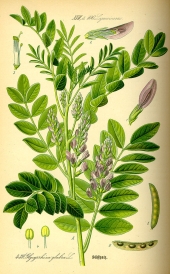Anise, A Medicinal Spice Steeped in History

Along with Licorice root, Anise is perhaps the most prominent sweet spice used in many Bitters formulas. It features in Swedish Bitters, Aromatic/cocktail Bitters and most of the older medicinal formulas. Perhaps most interestingly, it is used in the Dutch Beverage, Anijsmelk. Anijsmelk is a delicious anise/licorice flavored hot milk beverage that is popular in the Netherlands and Michigan's Upper Peninsula. It is a warming beverage, popularly used in the winter, and considered a sedative/soporific that induces a peaceful night's sleep. I absolutely LOVE it, btw! Of course, I love anything that tastes of licorice... and the concept of enjoying unique, delightful, relaxing beverages with beautiful women is remarkably appealing (of course, I am envisioning Sonja Henie in the classic Glenn Miller film, "Sun Valley Serenade"). I recall when my Ukrainian friend told me their tradition of the youngest, unmarried daughter in the family serving cherry brandy to any single man who was a guest. "That is it," I exclaimed, "I'm moving to Ukraine!" If I'm still single in a few more years, I very well might.
But, back to Anise. NaturalMedicinalHerbs.net lists Anise as:
Herb: Aniseed
Latin name: Pimpinella anisum
Synonyms: Anisum vulgare
Family: Umbelliferae
Medicinal use of Aniseed: Aniseed has a delicious sweet liquorice-like flavour and is a commonly used and very safe herbal remedy that is well suited for all age groups from children to the elderly. However, its use has declined in recent years with the advent of cheaper substitutes such as Illicium verrum and synthetic substances. It is a particularly useful tonic to the whole digestive system and its antispasmodic and expectorant effects make it of value in the treatment of various respiratory problems. The seed is the part used, generally in the form of an extracted essential oil. The essential oil comprises 70 - 90% anethole, which has an observed oestrogenic effect whilst the seed is also mildly oestrogenic. This effect may substantiate the herb's use as a stimulant of sexual drive and of breast-milk production. The essential oil should not be used internally unless under professional supervision whilst the seeds are best not used medicinally by pregnant women, though normal culinary quantities are quite safe. The seed is antiseptic, antispasmodic, aromatic, carminative, digestive, expectorant, pectoral, stimulant, stomachic and tonic. It is of great value when taken internally in the treatment of asthma, whooping couch, coughs and pectoral affections as well as digestive disorders such as wind, bloating, colic, nausea and indigestion. Externally it is used to treat infestations of lice, scabies and as a chest rub in cases of bronchial disorders. A strong decoction of the seeds can be applied externally to swollen breasts or to stimulate the flow of milk.
Anise was a very popular herb in the ancient world, cultivated by the Egyptians and used throughout the Middle East and Europe. Anise was even used as a form of currency and was an acceptable means of paying taxes. Anise is an herb mentioned in the Bible and was highly prized among Greek herbalists and Roman epicureans. Pythagoras wrote of its virtues in the 6th century BC and Hippocrates recommended it for coughs. Pliny said that Anise "removed all bad odors from the mouth" and could prevent bad dreams. In Rome, the use of anise baked into desserts to follow heavy meals may have been the origin of the wedding cake!
Anise spread throughout the spice routs and eventually became a popular medicine in England.
Gerard's Herbal, published in 1597, states:
Galen writeth, That the seed of Anise is hot and dry in the third degree: after others, it is hot in the second degree, and much less than dry in the second degree; for it engendereth milk, which it could not do if it were very dry, as Galen in his chapter of Fennel doth whether he will or no declare and testify; in that it doth engender milk, his opinion is that it is not hot above the first degree: which thing also may be in Anise seed, both by this reason, and also because it is sweet. Therefore to conclude, Anise seed is dry in the first degree, and hot in the second.
The Virtues.
A. The seed wasteth and consumeth wind, and is good against belchings and upbraidings of the stomach, allayeth gripings of the belly, provoketh urine gently, maketh abundance of milk, and stirreth up bodily lust: it stayeth the lask, and also the white flux in women.
B. Being chewed it makes the breath sweet, and is good for them that are short winded, and quencheth thirst, and therefore it is fit for such as have the dropsy: it helpeth the yexing or hicket, both when it is drunken or eaten dry: the smell thereof doth also prevail very much.
C. The same being dried by the fire and taken with honey cleanseth the breast very much from phlegmatic superfluities; and if it be eaten with bitter almonds it doth help the old cough.
D. It is to be given to young children and infants to eat which are like to have the falling sickness, or to such as have it by patrimony or succession.
E. It taketh away the Squinancy or Quinsy (that is, a swelling in the throat) being gargled with honey, vinegar, and a little Hyssop gently boiled together.
Most commonly used as a spice and a digestive aid, Anise made its way into nearly every culinary tradition, apothecary and confectionary in the world. Anise was a foundational herbs in "cough sweets", aperitifs, digestifs and Bitters. Anise features prominently in my Daily Digestive Bitters, the recipe for which can be found here:
https://southernappalachianherbs.blogspot.com/2020/09/my-daily-digestive-bitters-ddb-formula.html and is included in my recent podcast, Southern Appalachian Herbs: Show 4: Medicinal (and Tasty!) Herbs and Spices For Thanksgiving
https://southernappalachianherbs.blogspot.com/2020/11/show-4-medicinal-and-tasty-herbs-and.html
Few herbs are more beneficial and more enjoyable than Anise!









